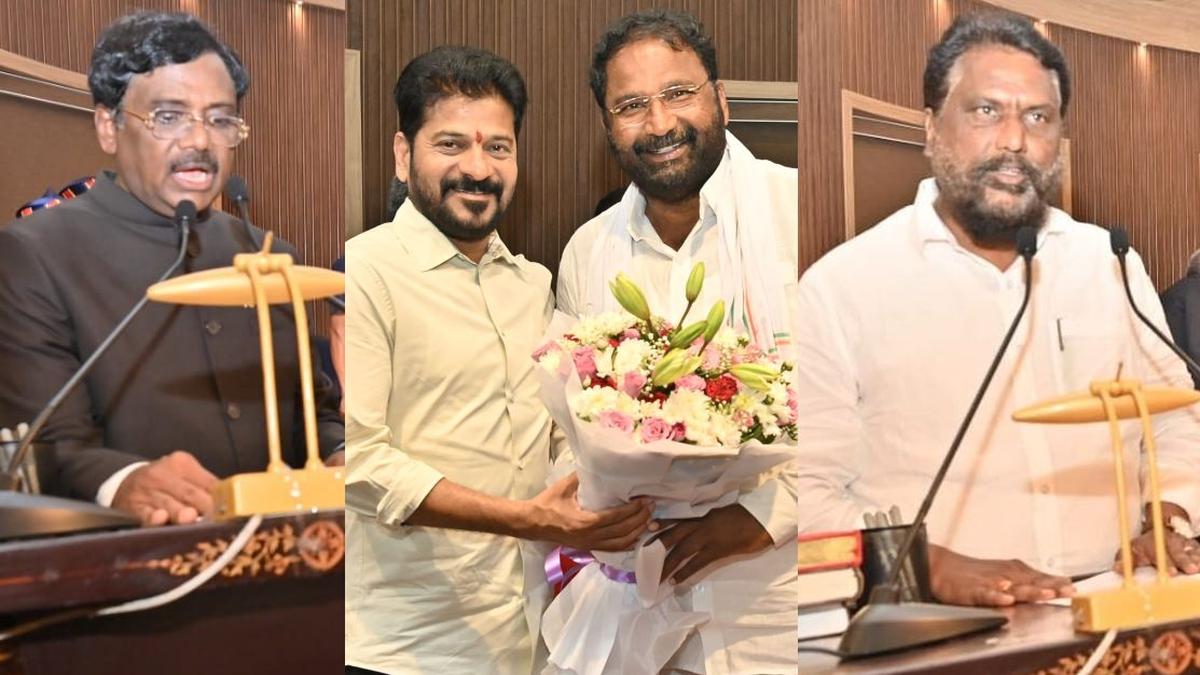In the sprawling landscaped compound of the Kadavu Nachiamman Temple of Nilavur in the Yelagiri Hills, a ‘malai koothu’ on Haribalan-Sivabalan Sandai was about to open. On that new moon night, the audience had arrived for the temple festival from as far as Jolarpet. They would stay up till dawn. “Here comes ‘Boppan’ for the opening Act.” ‘Boppan’, the buffoon, makes an entry in a jazzy orange outfit, prancing up and down to the blaring but often indiscernible vocals. The buffoon jumps, gets whipped, pretends to scare children seated on the ground, gets whipped again.
As the night advanced, a section of the audience dozes off with banners for blankets, while a few elders keep themselves warm, crouched beneath woollen blankets. An artist hurls profanities at Maradhanda Asuran, causing giggles, and falls on the lap of an old woman in the audience after a pretence-chase by Maradhanda Asuran. A ploy to keep the audience awake on that chilly night.
Tearful monologue
Haribalan-Sivabalan Sandai opens with Maradhanda Asuran and his daughter Sillingi, and Sillingi’s sons Haribalan and Sivabalan conceived of a boon from Lord Siva, according to mythology. Sillingi, played by an old man draped in a sari and a wig, comes out to narrate her story. Sillingi’s tearful monologue is interrupted when a visibly moved old woman, gets up and pins a currency note to Sillingi’s sari at the shoulder.
This would be the last act for this season from the Tamil month of Thai to Aadi.
‘Malai koothu’, a form of ‘therukoothu’ (street play), a seemingly plebeian art, is culturally moored in the lives of the inhabitants of the hills — the Malaiyali tribes of Dharmapuri and the Javadhu and Yelagiri Hills in Tirupathur. It is also an expression of social cohesion and is primarily performed as a temple dance form in the hills.
“We perform ‘koothu’ for temple festivals, births and deaths, and marriages,” says K. Govindasamy, former president of the Adhanur panchayat comprising 14 villages of the Yelagiri Hills. The 75-year-old is a veteran ‘koothu’ artist. He runs the Kadhavu Nachiamman Koothu Kuzhu that trains artists at Nilavur village. “We did not allow film songs to contaminate the form,” he says.
In the hills, the performers are high pitched so as to reach a larger assembly of audience while performing with no mikes, something that the artists from the plains find hard to emulate, says A. Thirumalaisami, an artist and researcher from the family of ‘therukoothu’ artists in the plains in Krishnagiri.
The ‘koothu’ centres around The Mahabharata and the Puranas. The story-telling revolves around Draupathi. The art form is closely associated with the regions that worship Draupathiamman in a dedicated temple, with a puritan style of performance seen in Krishnagiri, Tiruvannamalai, Villupuram, and Cuddalore districts. “The Therkathiya Bani (the southern style) is different from the Vadakathiya Bani (the northern style) seen in Kancheepuram and Chengalpattu districts. “Vanniya Puranam can be performed by anyone here; but in Tiruvannamalai, troupes comprising only Vanniyars perform it,” he explains.
Starting out as a dancing girl
“I learnt to read and write because of the ‘koothu’,” says Siriran, a septuagenarian artist and ‘koothu’ teacher in the Javadhu Hills. He dropped out of school in Class 1 to graze cattle. “When I was 13, I joined a ‘koothu’ troupe as a dancing girl. That was my first role.” Soon, he learnt to read and write by reading dialogues during the act. Today, he runs the Adiparasakthi Nadaga Kuzhu in the Pungampathunadu panchayat in the Javadhu Hills.
Mr. Siriran never dons the role of ‘asuran ’. “I did it twice, but I don’t feel good opposing the gods. I have donned the roles of Krishna, Siva, Arjunan, and Dharmar.” The epical roles are seen as self-fulfilling and expression of the righteousness of the performing artists. “You want to learn the art, when you see someone don the paint and mouth a dialogue to win over the audience. The young boys always want to perform a ‘woman’s act’,” says Mr. Siriran.
Value in attire
‘Malai koothu’ artists do not see themselves as commercial artists, unless they are called to perform. Unlike the ‘therukoothu’ artists, ‘malai koothu’ artists see value in the perfect attire that wins over the audience. “We spend about ₹15,000 for stitching our costumes. If we keep it safe, it can last 3-4 years. In the hills, we cannot rent clothes as the artists do in the towns. We do our own make-up, and we pay a value for our costumes since our art is in our costumes,” he says.
In the Yelagiri Hills dotted by high-end resorts, the employment for the artists often come from the ever-growing hospitality construction projects, when ‘koothu’ falls silent during the lean season that begins with the monsoon. But, in the remote villages of the Javadhu Hills with its marginal landholdings, the adult population is largely away in cities for construction work. “When there is a festival, we send word and the artists return,” says Mr. Siriran. A troupe of 15 may get paid ₹25,000-₹30,000. Good artists are called by “troupe companies” in the plains.
If ‘koothu’ and ‘koothadi’ are invoked as pejorative terms for those outside its experience, the art form is sacred for its practitioners. ‘Malai koothu’ has come a long way, but not the ‘koothadi’. “Back then, a burning log propped up in between a splintered bamboo held up on two sides would light up the ‘koothu’ all through the night. Then came the kerosene torch and the Petromax lamps,” says Mr. Govindasamy. For the artist, the precarity remains. There is the constant struggle to keep the audience engaged and strike a balance between the pleasure of pursuit of an art form that caters to an already struggling people and making a living by other gainful jobs.
Published - June 05, 2025 10:15 pm IST



.png)
.png)
.png)
















 2 days ago
7
2 days ago
7









 English (US) ·
English (US) ·